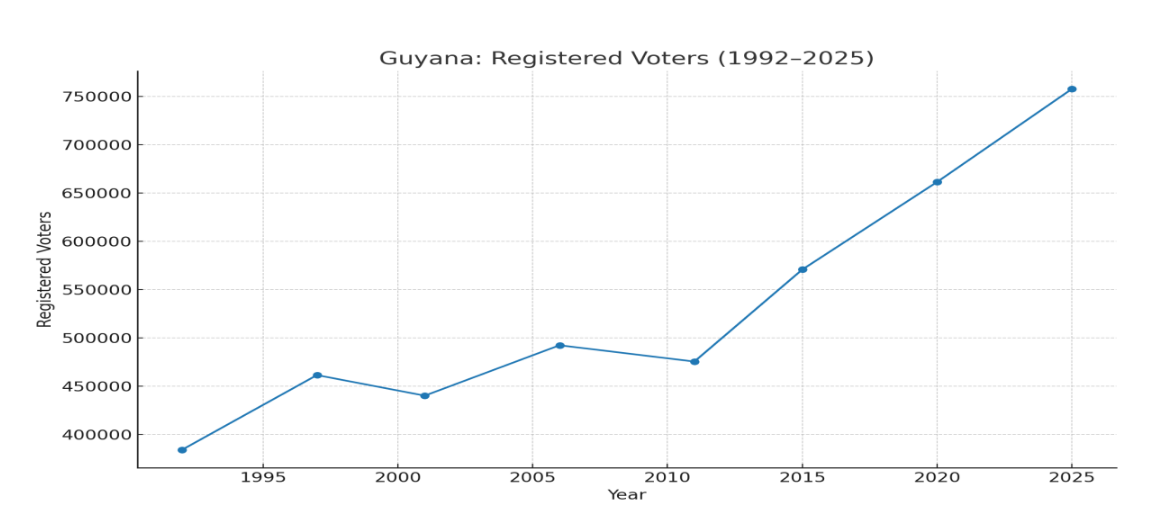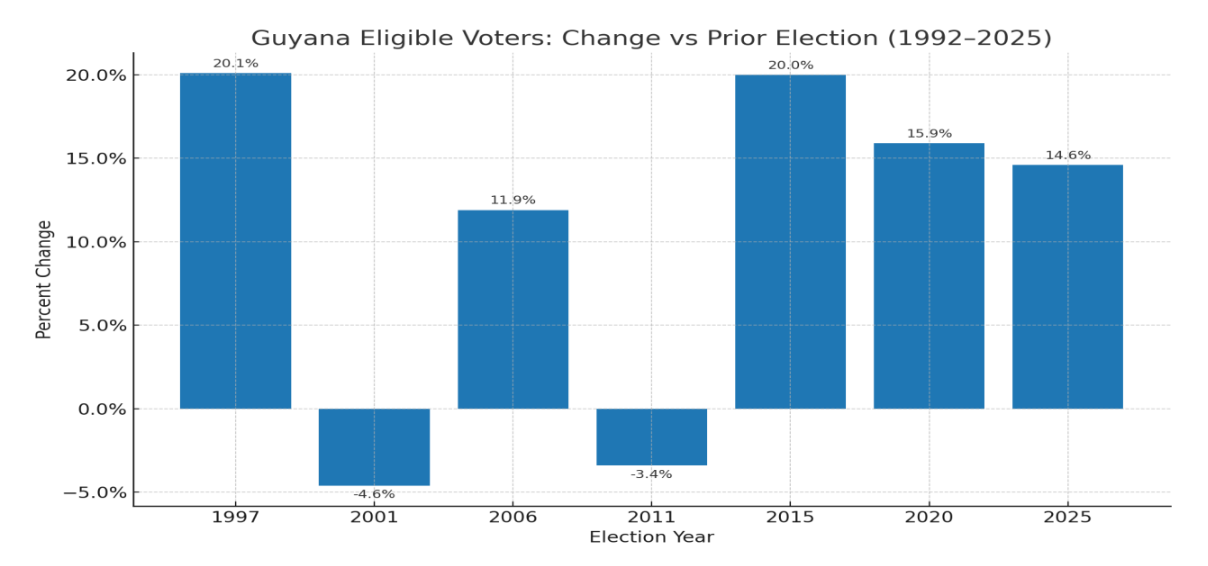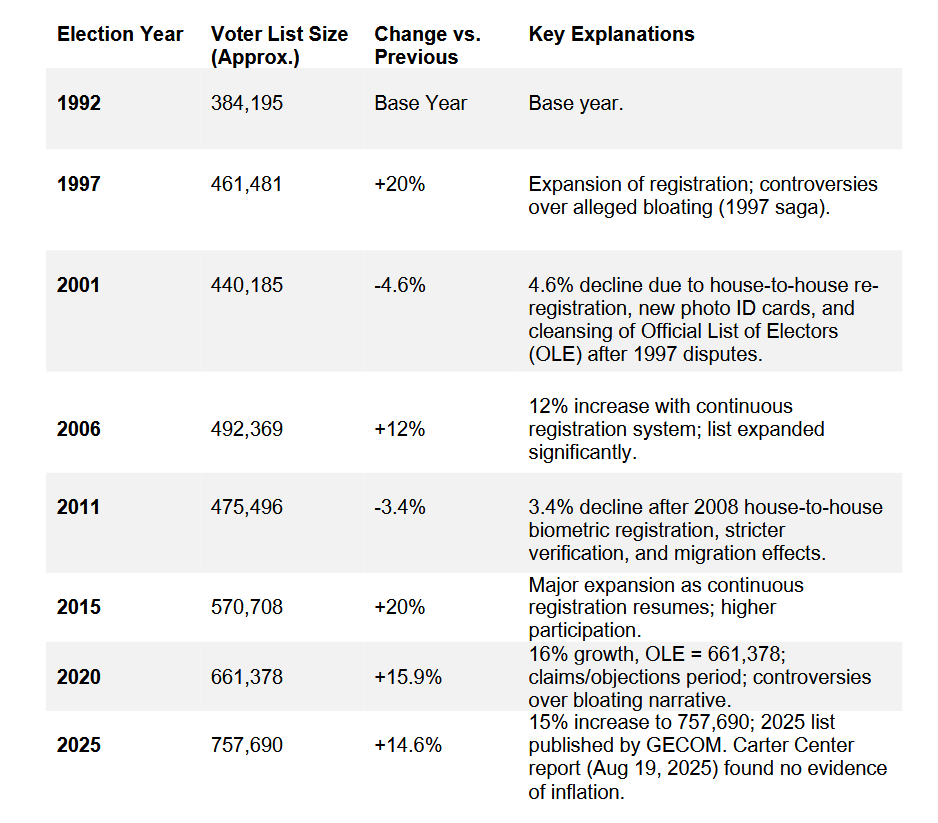Key Message: Guyana’s 2025 voters’ list, at 757,690, reflects lawful inclusion, demographic growth, and continuous registration—not bloat—confirmed by independent observers such as the Carter Center, underscoring the credibility of the electoral process ahead of the September 1, 2025, elections.
Key Insights
- 2025 mirrors 2020’s growth pattern: +16% (2015–2020) vs +15% (2020–2025) —representing a one-percentage-point decline over the previous cycle, not an outlier.
- Once registered, citizens cannot be removed from the OLE except by proof of death via a verified death certificate (CJ ruling ahead of 2020). Thus, overseas-based Guyanese who migrated after registering remain lawfully on the list.
- Continuous registration since 2005; multiple GECOM cycles since 2006 kept the roll current.
- Demographic pipeline: ≈256,000 from the 2012 Census cohorts matured into eligibility across 2015→2020 (160,000) and 2025 (≈96,000).
- Net return migration + new opportunities (oil & gas, concessions) expand the eligible pool.
Bottom line: The 757k (2025) voters’ list reflects lawful inclusion, demographic growth, and
ongoing maintenance—not ‘bloat.’
-
Introduction
The debate surrounding the integrity of Guyana’s voters’ list is neither new nor fleeting. Over the years, questions have frequently arisen about whether the list is “bloated,” particularly during and after contentious election cycles. One of the most prominent interventions came from businessman Mr. Stanley Ming, who advanced the argument—backed by what he described as mathematical analysis—that the Official List of Electors (OLE) could not credibly contain over 500,000 registered voters. His reasoning implied that tens of thousands of ballots cast should be considered invalid, thereby challenging the legitimacy of the electoral process.
That debate resurfaced most sharply during the national elections’ saga of 2020, where concerns about the size of the voters’ list became central to the political discourse. At the time, opposition figures argued that the government’s electoral mandate rested on a “bloated list.” These claims were even conveyed to senior U.S. officials during their engagements with Guyanese stakeholders, where reference was made to the national recount which showed 460,352 ballots cast against 661,378 eligible voters.
Fast-forward to today, the issue has once again come into sharp focus as Guyana prepares for General and Regional Elections due on September 1, 2025. The Guyana Elections Commission (GECOM) has published the current electors’ list, showing an increase from 661,378 voters in 2020 to 757,690 in 2025. Notably, the Carter Center’s pre-election observer report, released on August 19, 2025, found no evidence of an inflated voters’ list, directly challenging the recurring narrative of “bloating.” This assessment underscores the need to examine the matter through a longer historical lens rather than episodic political claims.
Against this backdrop, it is timely to revisit the issue, not as a matter of partisan contestation, but through a systematic analysis of voter registration trends over the last three decades. From 1992 through to 2025, the evolution of the voters’ list reflects demographic shifts, institutional reforms, and administrative practices. A careful trend analysis allows us to move beyond speculative arguments and instead ground the discussion in data and historical context.
Henceforth, this report provides a historical analysis of voter registration trends in Guyana from 1992 to 2025. The data illustrates the overall upward trajectory of the voters’ list, with notable declines in 2001 and 2011. These declines were tied to major electoral reforms such as the introduction of photo ID cards in 2001 and biometric house-to-house registration in 2008. The chart and table below contextualize these changes against continuous registration periods and population growth.
-
Discussion and Analysis
The trend: steady growth. The long‑run series (1992–2025) shows normal ebbs and flows, with two very similar growth intervals anchoring the recent period: 2020 vs 2015 at +15.9% and 2025 vs 2020 at +14.6%. That’s essentially the same growth band repeated, not an anomaly. And, as confirmed by recent diaspora studies and election‑observer analysis, Guyana’s exceptionally high emigration rate implies many eligible citizens reside overseas yet remain lawfully on the register— so a larger total, including the 2025 figure (≈757,000), is credible and justifiable. Furthermore, as one would recall, as well, that following the announcement of the national cash grant in 2024, many Guyanese abroad returned home to register for same, which would have contributed to the higher level of registered voters.


Table: Voter Registration Trends (1992–2025)

Key contextual points that explain the level and trajectory of the list:
- Demographic Maturation in 2025: The 2025 OLE shows a 15% increase over 2020, equivalent to 96,312 new voters. This figure aligns with expectations derived from the 2012 Census population data.
- Contribution from 2012 Census Cohorts (Ages 0–9): In 2012, the 0–4 age group numbered 70,440, while the 5–9 group was 71,268. Combined, these cohorts totaled 141,708 potential new electors by 2025.
- Within the 0–4 group, some individuals would have already turned 5 in 2012 and thus reached voting age by 2025. By contrast, all members of the 5–9 group in 2012 would be eligible to vote in 2025.
- Observed vs. Expected Variance: The actual OLE increase of 96,312 new voters accounts for 68% of the combined 0–9 cohorts from the 2012 census. This strongly supports the credibility of the observed demographic-driven rise in the 2025 voter roll.
- Earlier Cohort Maturations: From the same census, the 15–19 cohort (84,789) reached eligibility by 2015. The 10–14 cohort (83,139) matured by 2020. Together, these two cycles produced over 160,000 new eligible voters before 2025, supplementing later maturations.
- Overseas Guyanese remain on the list by law: Migration Policy Institute (2022) – “Discovery of Oil Could Bring Migrant Labor Opportunities … for Guyana” estimates that approximately 550,000 Guyanese reside abroad, describing Guyana as one of the world’s highest emigration rates. It is also a widely held view that the population of Guyanese residing abroad is greater than the resident population.
- Ahead of the 2020 election, the Chief Justice reaffirmed that registered citizens cannot be removed simply because they reside overseas as per the Constitution; they may vote if they return home.
- Continuous registration since 2005: Guyana moved to ongoing registration rather than rebuilding the list each election. GECOM has conducted multiple update cycles since 2006.
- Remigration and opportunity: since 2015, oil & gas opportunities and incentives (e.g., duty- free concessions) encouraged thousands to return, adding to the eligible voter pool.
- Attrition is accounted for: The voter list is continuously updated, as GECOM receives monthly reports to remove deceased persons, ensuring alignment with reality. Additionally, during the claims and objections period, any remaining deceased individuals on the list can be identified and removed.
-
Data, Methods & Limitations
This analysis draws on multiple data sources and contextual evidence to assess the credibility of the voters’ list in Guyana. Primary figures for voter registration were taken from GECOM’s Official List of Electors (OLE) for each election cycle from 1992 to 2025 (in some cases cited by other election observer mission reports). Historical data on voter registration trends were also cross- referenced with the national census, continuous registration exercises, and electoral reform records. In addition, reports by credible observer missions such as the Carter Center and judgments from the Guyana judiciary were incorporated to validate the integrity of the electoral roll.
Limiting Conditions
While the analysis uses official administrative and observer data, several limitations remain:
- Migration impact: Guyana’s exceptionally high migration rate means many registered citizens live abroad yet remain lawfully on the list, complicating direct comparison with the resident population.
- Census intervals: Census data in Guyana are not frequent, limiting the precision of demographic baselines for voter eligibility.
- Administrative assumptions: While GECOM regularly updates the OLE, assumptions about attrition and remigration are based on estimates rather than continuous tracking.
-
Conclusion
The long-run trend from 1992 through 2025 demonstrates that growth in the voters’ list is consistent with demographic expansion, legal provisions regarding overseas Guyanese, and institutional reforms such as continuous registration. The declines observed in 2001 and 2011 correspond to deliberate reforms that introduced new ID and biometric systems, rather than demographic contraction.
The recent increase from 2020 (661,378) to 2025 (757,690) mirrors earlier growth intervals and is further corroborated by demographic maturation evidence from the 2012 Census. Specifically:
The 2025 OLE shows a 14.6% increase over 2020, equivalent to 96,312 new voters, a figure fully consistent with expectations from census data. The 0–4 (70,440) and 5–9 (71,268) cohorts in 2012 together accounted for 141,708 individuals who would have reached voting age by 2025. By 2025, all of the 5–9 group and most of the 0–4 group would be eligible, meaning the observed OLE increase of 96,312 represents 68% of these cohorts, strongly aligning with demographic reality.
Independent validation reinforces this conclusion. The Carter Center’s pre-election report (August 19, 2025) found no evidence of an inflated list, confirming that the growth is credible and consistent with both demographic dynamics and institutional safeguards.
Therefore, the voters’ list as it stands is credible, and concerns of “bloating” are not supported
by either the demographic evidence or independent observation.





